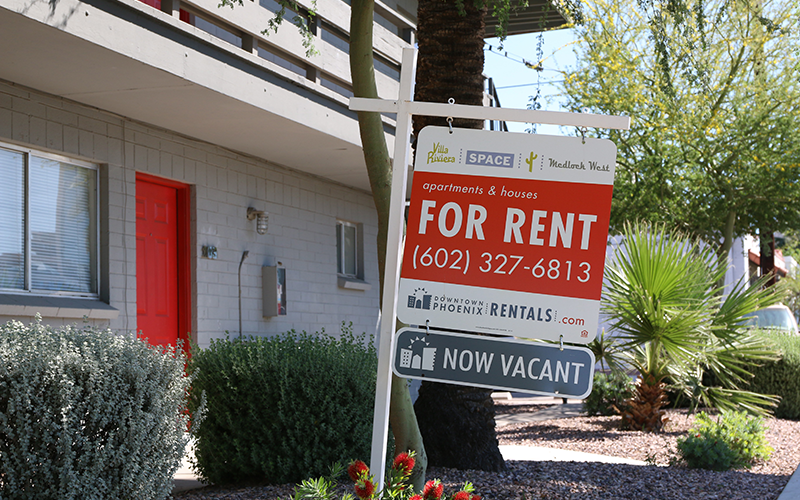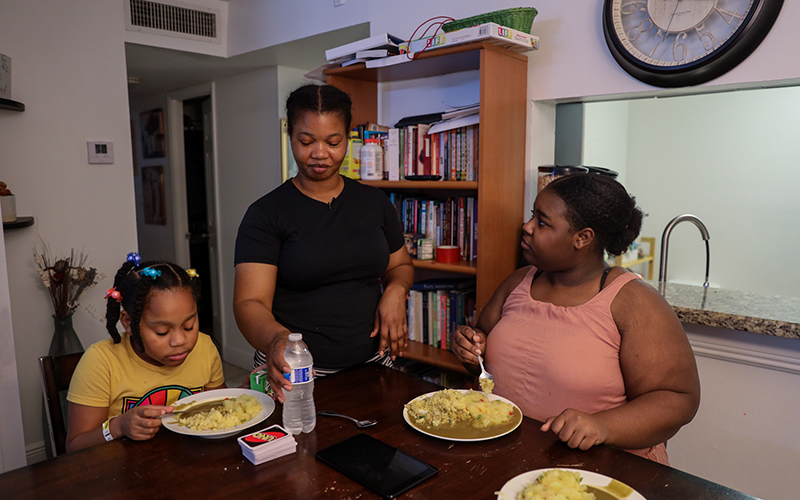
Rose Senat serves dinner to her daughters – Kate, 8, and Bianca, 15 – at home in North Miami, Florida. She will use the meal’s ingredients, lentil soup, couscous and papaya, several more times before the week is up. (Photo by Robert Tann/News21)
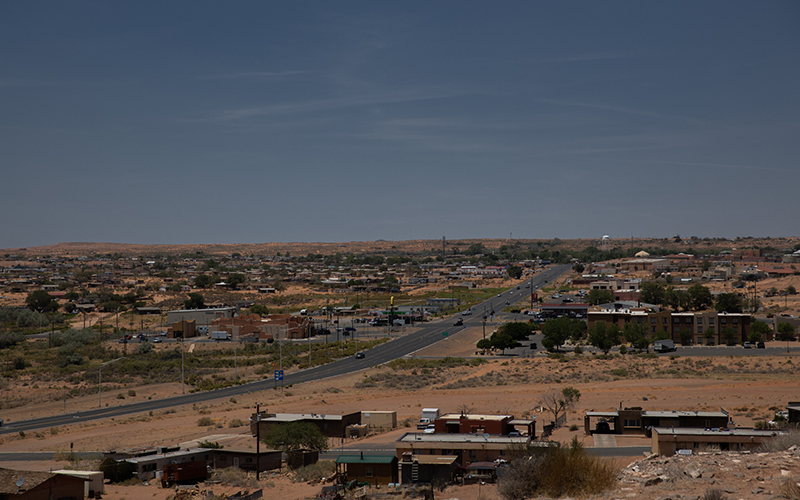
Moenkopi, on the Hopi Reservation in Arizona, is surrounded by the Navajo Nation Reservation. Both are considered food swamps – areas that lack fresh food but have an abundance of unhealthful fast food chains. (Photo by Robert Tann/News21)
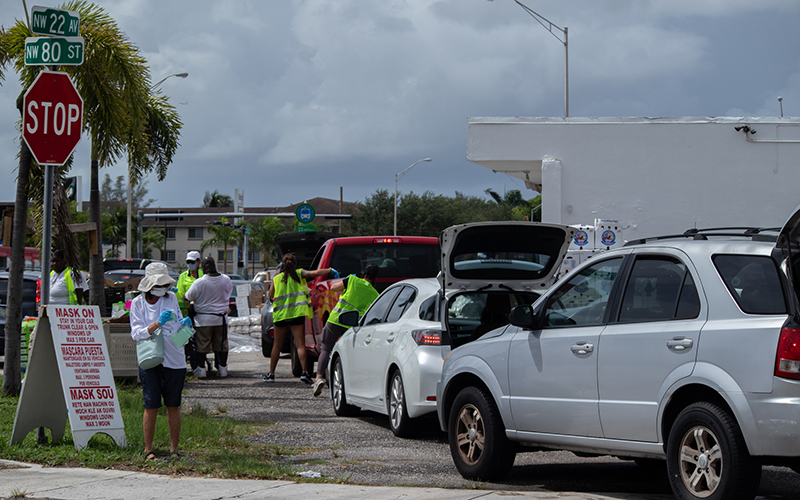
Volunteers at Glory Temple Ministries in North Miami, Florida, load vehicles with produce, rice and canned foods. At left, Annie Bandez handles intake forms on the distribution line. The sign gives instructions in English, Spanish and Creole. (Photo by Meghan Hall/News21)
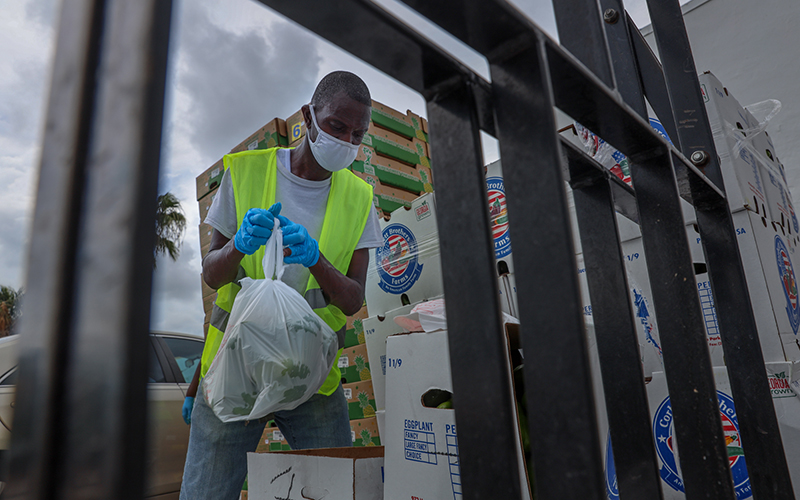
Fred Jones, a volunteer for Glory Temple Ministries in North Miami, bags green peppers during an afternoon food drive. At the height of the pandemic, the pantry fed up to 1,200 families a week. (Photo by Robert Tann/News21)
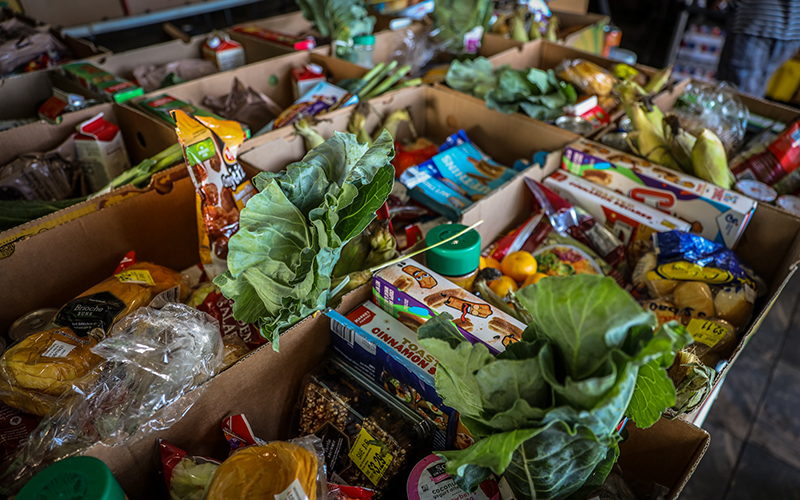
An assortment of food is packed into boxes before distribution during an afternoon food drive at Good News Community Food Pantry in North Miami. (Photo by Robert Tann/News21)
Rose Senat wound her way through a supermarket in North Miami, Florida, grabbing what she needed for the week ahead. Two loaves of bread. Two cartons of milk. A dozen eggs. And, of course, something to give her children. Cheetos would do.
She didn’t pay with cash, debit or credit but with a government issued card for food assistance. The Pandemic Electronic Benefit Transfer, issued under one of the first coronavirus response bills passed by Congress, allots money to families with children who have missed out on free school meals because of remote learning.
Senat, who feeds a family of seven, said her card arrived in April, but because she didn’t understand how the program works, she didn’t use her benefits for three months.
“Thank God when I activated that card, it was $1,500 … that was a blessing to us,” she said.
As COVID-19 ravaged America, hunger soared and families suffered from uncertainty over their next meal, with more than 1 in 6 households reporting food insecurity, according to the Urban Institute. Through a dramatic expansion of food assistance benefits, such as P-EBT, the federal government brought temporary relief to millions of Americans. But as the programs wind down, families and experts fear a new surge of hunger.
“We’re very, very conscious to what is going to happen in the fall when some of these benefits end and we start to see a cliff effect,” said Catherine Lynn, a spokeswoman for the Greater Boston Food Bank.
As food banks prepare for another wave of hunger to strike a nation in recovery, organizations and people have become self-reliant. Small-scale gardens and low-priced farmers markets have taken root in certain communities.
But designating more federal money to people could be the best way forward, experts said, even if it costs billions.
“Eliminating food insecurity in the United States is easy,” said Craig Gundersen, professor of agricultural and consumer economics at the University of Illinois at Urbana-Champaign. “All we have to do is two things: increase (nutrition assistance) benefit levels and expand eligibility.”
Americans last year got a glimpse of what an expanded food safety net could look like. But as cases of COVID-19 have rebounded in most parts of the country, the federal government hasn’t promised any further extension of heightened benefits, leaving those who have received emergency aid in a state of uncertainty.

Rose Senat received a P-EBT card in April, giving her money to use on food for her family. But she didn’t use the card for several months because she didn’t understand how the program works. (Photo by Robert Tann/News21)
Surviving on a safety net
Senat placed a still-hot plate of couscous, grilled papaya and lentil soup on her dining table.
“Eat your food as medicine, otherwise you will need to eat your medicine as food,” she told her unsure children as they scooped up a spoonful of papaya.
Senat would use these essential ingredients several times before the end of the week in an attempt to stretch out what she had. Although she still relies on food pantries, her P-EBT card allows her to buy what the pantries don’t give her, such as a bag of frozen vegetables to complement her couscous.
Without the federal aid, Senat’s food choices would have been restricted by price, “but with the EBT you feel free to buy … what you want,” she said.
Across America, food-insecure households found themselves with more choices, thanks in part to a boost in benefits. Along with P-EBT, the federal government bolstered the Supplemental Nutrition Assistance Program, or SNAP, which formerly was known as food stamps.
Nationwide, the program saw an increase of more than 5 million recipients during the first year of the pandemic, with more than 42 million Americans enrolled as of March 2021.
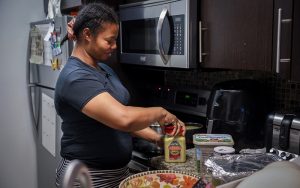
Before the pandemic, Rose Senat says, she visited only one food pantry each week. But with her husband’s hours cut and his pay reduced, Senat frequents three or four pantries a week. (Photo by Robert Tann/News21)
The Trump administration, as part of its response to the pandemic, expanded SNAP eligibility to more households and increased the monthly benefits by 15%.
President Joe Biden extended the heightened SNAP benefits through the end of September, but as of June, more than a dozen states have severed aid early.
For Janet Burns, a single mother of four in St. Louis, the 15% boost in benefits proved crucial to her family’s survival.
“If you want to get actual healthy food, it costs more,” Burns said. “So I’m more freed up to buy more healthy things now than I was beforehand.”
In March 2020, she said, she received $539 monthly. By July, as a provision of the Families First Coronavirus Relief Act, her monthly benefits rose $90, to $629.
The 15% increase in SNAP benefits dramatically expanded food security throughout the country.
Elaine Waxman, a senior fellow at the Urban Institute, said before the pandemic, SNAP failed to cover the cost of a modest meal in 96% of all 3,006 U.S. counties. But with the boost in benefits, SNAP now covers that cost in nearly 60% of counties.
“I think that tells you the power of the 15%. It makes a big difference,” Waxman said.
Still, Burns’ boosted benefits only sustain her and her three children – 18, 16 and 10 – for part of the month.

Janet Burns sits in Hyde Park near her home in St. Louis. Burns’ tarot card readings brought in about $700 monthly for her family during the pandemic, her only source of income. (Photo by Maxwell Shavers/News21)
“I kind of have to scrape for the last week,” she said.
With less income, Burns decided to stop spending money out of pocket on food. Her only source of income comes from her work as a tarot consultant. She reads clients’ tarot cards via Facebook Live, which brings in about $700 a month. To carry her family through the pandemic, Burns has relied on premade school meals, food pantries and SNAP.
Across the country, federal aid also came in the form of unemployment benefits and stimulus checks. But for those who did not receive SNAP, P-EBT or similar targeted food assistance, money for food quickly dried up.
Food was “honestly, probably like one of the second or third priorities. It’s definitely bills, car payments, phone bills, internet bills,” said Calsie Sockyma, who lives in Tuba City, Arizona, and received two stimulus checks. “It would be like maybe $200 … left over for a month of food.”
Sockyma and her mother, Joyce Kaye, both Hopi Tribe members, live on neighboring reservations in northeast Arizona. Even before the pandemic, the two struggled with how and when to eat. With only one grocery store in a community of 8,600, Sockyma and Kaye have to drive at least an hour to the larger cities of Flagstaff or Page for supplies.
Sockyma is vegetarian, and Kaye is vegan. With a commitment to eating natural foods, the two have a hard time finding fresh produce, a problem Sockyma said SNAP could help eliminate.

Tuba City, on the Navajo Nation Reservation in northeastern Arizona, has only one grocery store for roughly 8,600 residents, forcing many to drive at least an hour for fresh food. (Photo by Robert Tann/News21)
Although she has tried repeatedly, Sockyma hasn’t been approved for SNAP benefits. Sockyma lost her job at Buffalo Wild Wings early in the pandemic and received unemployment benefits soon after. She lost that assistance in March.
“I was probably unemployed for about a month and a half without benefits,” she said. “It was very stressful. I have a car that I have to make payments on that I depend on using to get me to places. And also like, what am I going to do for food?”
Senat, the mother of seven in Florida, turned to food banks. Before the pandemic, she used to shop there once a week. But when her husband’s pay was cut, she started making three or four trips every week.
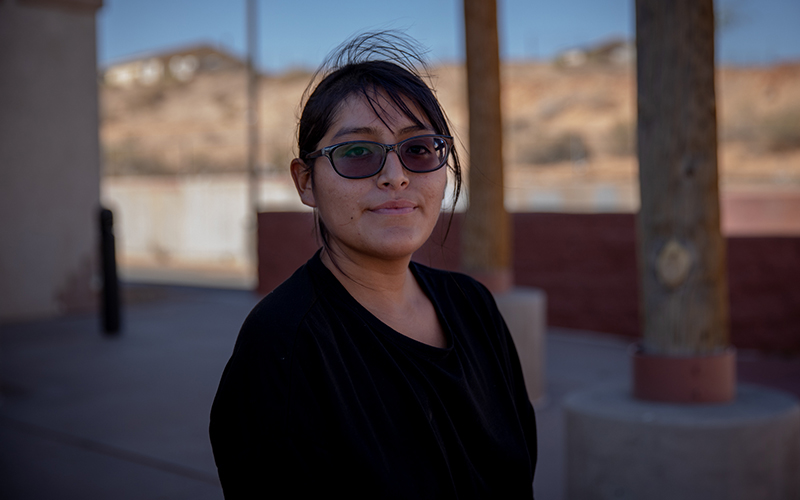
Calsie Sockyma, a Hopi who lives in Tuba City, was trying to apply for SNAP benefits even before the pandemic. Since losing her unemployment benefits in March, she has been looking for a second job to pay the bills. (Photo by Robert Tann/News21)
Longer lines and less food
Every Wednesday at 7 a.m., drivers line up in cars and trucks on the streets outside of Good News Community Food Pantry in North Miami for a food distribution that won’t start for eight hours.
As the day drags on and the humidity rises, waiting families swing their legs out of open car doors. If drivers keep their cars running with air-conditioning, the cars would run out of gas before the pantry’s gates opened. In the afternoon, Senat drives up in her red Toyota Camry.
“Sometimes the line is long, and my car doesn’t have enough gas,” Senat said.
On those days, Senat said she goes home, hoping the line will be shorter later in the day. Sometimes when she returns, there’s no food left.
Food banks affiliated with Feeding America, the nation’s largest hunger-relief organization, fought to meet demand across the country. Ultimately, small food pantries and partners bore the brunt of that reality.
Dorise Berrouet, founder of Good News, helped Senat’s family before the pandemic. But as the need skyrocketed, Berrouet saw more than four times the number of families – at times nearly 500 people every week – at her door.
“It was very, very difficult to find food to feed all those people that were coming in,” Berrouet said. “We had to close our gate because we didn’t have any food to feed them.”
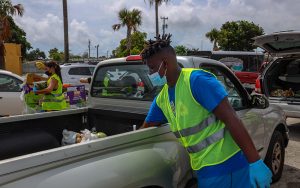
A volunteer for Glory Temple Ministries in North Miami, Florida, loads food into a pickup truck during an afternoon food drive. As large food banks faced supply issues in the pandemic, smaller pantries had to turn families away. (Photo by Robert Tann/News21)
Lynn, the Greater Boston Food Bank spokesperson, said the food bank used to operate on a first-come, first-served basis for its appointments. But as the pandemic plunged millions into food insecurity, larger organizations filled up more appointments, leaving smaller partners unable to request food despite the heightened demand.
“We sort of overnight had a situation where there were some larger agencies like American Red Cross, Catholic Charities – huge multiservice agencies – who were coming in every single day, some multiple times a day, because they had the capacity to do so,” Lynn said. “And then it sort of boxed out some of the smaller agencies who just couldn’t get an appointment.”
Berrouet said the U.S. Department of Agriculture, which helps to supply food banks, provided only about two-thirds of the food she received before the pandemic was declared in March 2020. At times, one of her major suppliers, Feeding South Florida, a Feeding America affiliate, did not have food to offer her. Some families that came to Good News left empty-handed.
“To turn people away, it breaks my heart,” Berrouet said.
At the pandemic’s height, said Ronae Cambridge, pastor of Glory Temple Ministries in North Miami, lines for food stretched more than 25 blocks, and her pantry fed 1,000 to 1,200 families each week. But as demand grew, supply slowed.
“At one point in time, it was like a month or two, nobody seemed to have any food that we knew of,” Cambridge said. “Major food banks were running low on food, and we just didn’t have it.”
At the beginning of the pandemic, Feeding South Florida received federal funds for food assistance programs, according to spokesperson Sari Vatske. When that ended in December, Vatske said, the organization faced a “commodity cliff.”
“During the height of the pandemic, we were distributing anywhere on average from 14 to 17 million pounds of food per month,” Vatske said. “And now we’re back down to pre-COVID levels of 6, 7 million pounds.”
But that doesn’t meet the needs of South Floridians, Vatske said.
As pressure mounts on food banks to feed what they predict will be an influx of families as federal assistance runs out, some Americans have adopted small-scale solutions to the food crisis.
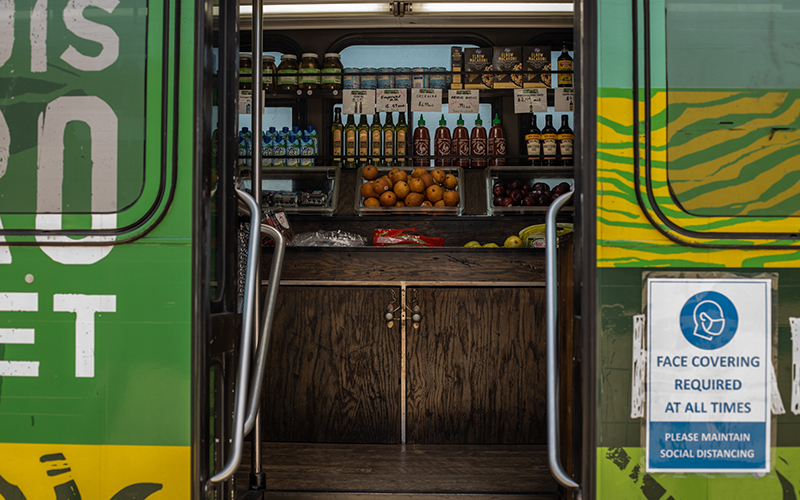
The St. Louis Metro Market sits in the O’Fallon YMCA parking lot before customers arrive. The market, in a converted city bus, sells produce and cooking essentials at wholesale prices to people with little access to healthful food. (Photo by Sara Metz/News21)
Imperfect solutions
At the O’Fallon YMCA west of St. Louis, Tiffany Taylor sits behind the counter inside a city bus converted into a food pantry, chatting with each customer. A rainbow assortment of fruits and vegetables lines each wall, meant to nourish a neighborhood.
“Our greens are on sale this week,” Taylor says. “Don’t they look good?”
Taylor works there for two hours each Friday, handling purchases and encouraging customers to spend enough to earn a stamp on their loyalty cards.
“Do you have your card?” she asks customers. “If you fill it, you get $10 off!”
The Metro Market bus sells produce and such cooking staples as coconut oil and butter at wholesale. Although it had to cease in-person operations for much of the pandemic, it reopened its doors in May and added new stops in a continued push to feed St. Louis area families.
The executive director, Quinton Ward, said the market offers access to nutritious options for families in what he calls a “food swamp.”
“When I say food swamp, we’re talking about places where it’s not necessarily that there’s just no food,” Ward said. “But the options that are available are not healthy, are not conducive to a good quality of life.”
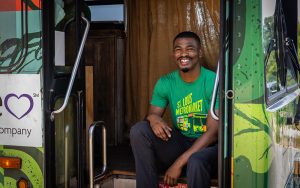
Quinton Ward, the executive director of the Metro Market, says the market helps families access nutritious food in “food swamps.” Shoppers say the bus provides an affordable, high-quality alternative to the produce they could buy at a food store. (Photo by Sara Metz/News21)
Shakira Nasiruddin, who shops at Metro Market, said fresh food is hard to get in some neighborhoods in St. Louis.
“There’s so many of us who want to get back to our roots and cook fresh food, but we don’t have access to it,” Nasiruddin said. “Frozen food and all of the canned stuff, we just don’t want them.”
In more rural areas, food is even more difficult to come by.
Tucked behind the red Navajo sandstone cliffs of Moenkopi, Arizona, is a small but fertile plot of land for crops. Kaye, the Hopi native and mother of Sockyma, is growing what she can there.
I’m “very happy, because I can grow, I can grow,” Kaye said as she pointed to a patch of blue corn, the sprouts noticeably taller than the day before.
Kaye and Sockyma are learning to live off their land. Kaye cares for patches of land her father owns. For the two, farming has both allowed them to secure fresher foods and connect more to their past.
“I noticed that we become … dependent on the grocery stores and our transportation to get us fresh food,” Sockyma said. “We kind of lost those traditions and those cultural practices, especially for the youth.”
But, experts said, growing produce in backyards is not the path to feeding America in the future.
“I have not seen those able to meet the scale of the problem, the ways in which our federal nutrition programs are able to do,” said Allison Bovell-Ammon, policy director at Children’s Health Watch in Boston. “We know that the local community gardens and even urban farms or other things really cannot produce the resources at scale that we need in order to fully solve the problem of food insecurity.”
Gundersen, the agricultural and consumer economics professor, said that although the policies of the Trump and Biden administrations quelled a rise in hunger, the programs do not go far enough to ensure lasting change.
A study by Craig Gundersen at the University of Illinois proposes that the government permanently increase SNAP benefits by 25% – a 10-percentage-point increase from pandemic-era levels – and further expand eligibility to reach even more families straddling the poverty line.
“Let’s not look at COVID as a one-off, but instead look at it like these are problems before COVID – they’ll be problems after COVID if we don’t do something,” he said.
The Biden administration, coming off the heels of its $1.9 trillion stimulus bill, has pledged to revise the Thrifty Food Plan, the system for determining SNAP eligibility. The administration has said the criteria are out of date with today’s rising food prices. A review could see a new increase in benefits as soon as Oct. 1, a day after the 15% boost in benefits is slated to end.
“I think the pandemic has allowed us to see what a future could look like,” said Waxman, at the Urban Institute.
But as benefits begin to fall off, families in need know it’s a future they may not see.
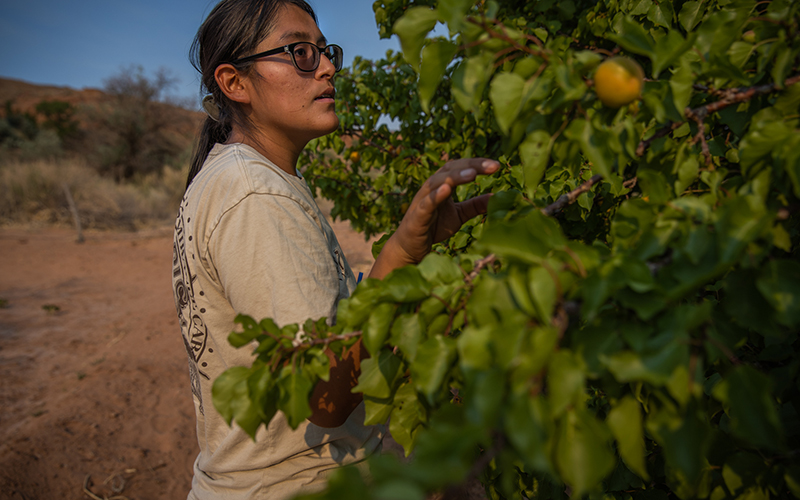
Calsie Sockyma reaches for an apricot as dusk sets on a plot of land her mother farms in Moenkopi, Arizona. Sockyma and her mother, Joyce Kaye, have turned to farming as a way to eat more healthfully in a place where fresh food is hard to find. (Photo by Robert Tann/News21)
Kaye and Sockyma said leaving their reservations would mean access to better food options. But it will take a reserve of money they do not yet have.
Senat, the mother in North Miami, knows that when her P-EBT runs out, she’ll see hungry children and less food in the fridge.
Burns, the tarot card reader in St. Louis, will be faced with hard choices of what to buy once she loses her extra $90 in monthly SNAP money.
“I’m broke,” Burns said. “I don’t have the steady income I had before everything took place.”
With other bills to pay, Burns said she doesn’t know what she will do when her SNAP benefits shrink.
“Them dropping back down? Oh, that would be hell.”
This report is part of Unmasking America, a project produced by the Carnegie-Knight News21 initiative, a national investigative reporting project by top college journalism students and recent graduates from across the country. It is headquartered at the Walter Cronkite School of Journalism and Mass Communication at Arizona State University. For more stories, visit unmaskingamerica.news21.com.
